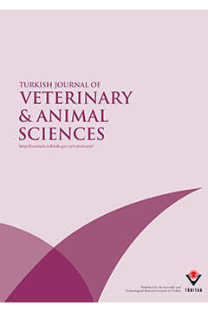DNA Hybridization of Escherichia coli Strains Isolated from Uteri and Fecal Samples of Bitches with Pyometra
Escherichia coli is the most common bacterium that has been isolated from the bacterial culture of uterine and fecal samples of dogs with pyometra. The aim of the present study was to determine whether this organism could be relevant to the pathogenesis of pyometra in dogs. Fecal and uterine samples were collected from 17 bitches with pyometra. E. coli strains were isolated in all samples. Representative colonies of E. coli from each sample were analyzed for pathogenicity determinants by hybridization with HRP-conjugated DNA probes for enteropathogenic (eaeA), verotoxigenic (VT1, VT2), enterohemorrhagic (EHEC), enterotoxigenic (ETEC), enteroaggregative (EAggEC) and enteroinvasive (EIEC) E. coli. A verocell assay for cytotoxic necrotizing factor (CNF) was performed. Fecal analyses showed that the dogs were excreting pathogenic E. coli that hybridized with probes for eaeA (47%), VT1 (29%) and EIEC (17%) compared with the uterine samples in which both eaeA and VT1 (41%), and EIEC (5%) positive E. coli were found. All samples were negative for VT2, EHEC, ETEC and EAggEC probes. A verocell assay confirmed the presence of CNF in the positive samples from feces (29%) and uterine samples (17%). CNF-positive samples from dogs with pyometra were also positive for CNF in fecal samples. These findings suggest that pathogenic E. coli may play an important role in pyometra and the strains isolated from the uteri may be similar to isolates from feces. Further studies are needed to examine their potential role in the pathogenesis of pyometra in dogs.
DNA Hybridization of Escherichia coli Strains Isolated from Uteri and Fecal Samples of Bitches with Pyometra
Escherichia coli is the most common bacterium that has been isolated from the bacterial culture of uterine and fecal samples of dogs with pyometra. The aim of the present study was to determine whether this organism could be relevant to the pathogenesis of pyometra in dogs. Fecal and uterine samples were collected from 17 bitches with pyometra. E. coli strains were isolated in all samples. Representative colonies of E. coli from each sample were analyzed for pathogenicity determinants by hybridization with HRP-conjugated DNA probes for enteropathogenic (eaeA), verotoxigenic (VT1, VT2), enterohemorrhagic (EHEC), enterotoxigenic (ETEC), enteroaggregative (EAggEC) and enteroinvasive (EIEC) E. coli. A verocell assay for cytotoxic necrotizing factor (CNF) was performed. Fecal analyses showed that the dogs were excreting pathogenic E. coli that hybridized with probes for eaeA (47%), VT1 (29%) and EIEC (17%) compared with the uterine samples in which both eaeA and VT1 (41%), and EIEC (5%) positive E. coli were found. All samples were negative for VT2, EHEC, ETEC and EAggEC probes. A verocell assay confirmed the presence of CNF in the positive samples from feces (29%) and uterine samples (17%). CNF-positive samples from dogs with pyometra were also positive for CNF in fecal samples. These findings suggest that pathogenic E. coli may play an important role in pyometra and the strains isolated from the uteri may be similar to isolates from feces. Further studies are needed to examine their potential role in the pathogenesis of pyometra in dogs.
